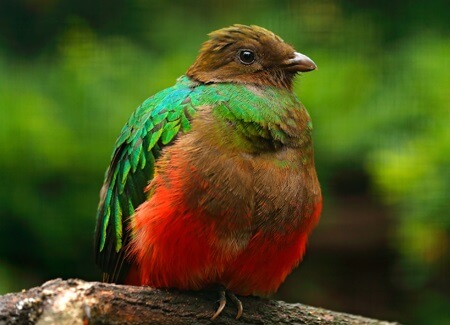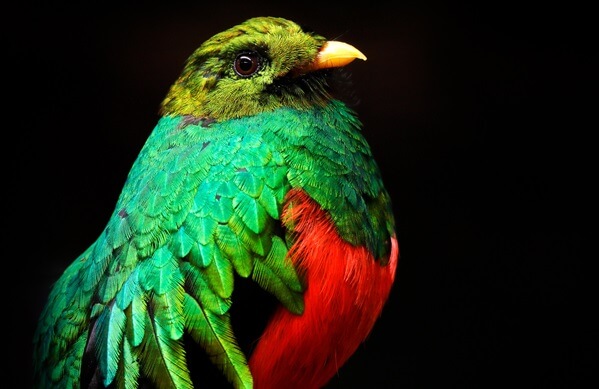
A handful of spectacular species, found only in the Americas, are known as “quetzals.” All are part of the trogon family — colorful, fruit-eating tropical birds that include the better-known Resplendent Quetzal and Haiti's national bird, Hispaniolan Trogon.
The name "quetzal" is from the Nahuatl (Aztec) quetzalli, meaning "large brilliant tail feather," and Golden-headed Quetzal fits the bill perfectly. This beautifully plumed species has a distinctive golden-bronze head, iridescent green body and wings, and long wing and tail coverts.
Beyond beauty, the Golden-headed Quetzal's shimmering green and gold plumage provides effective camouflage in its arboreal habitat. Combined with its habit of perching quietly, usually on a horizontal branch in the forest canopy, this big, flashy bird remains surprisingly inconspicuous.
Forest Gardener
Throughout much of its range from the northern Andes south to Bolivia, the distribution of Golden-headed Quetzal overlaps with that of the Crested Quetzal. It's possible to see or hear both species at the same site (including at the ABC-supported Buenaventura Reserve in Ecuador).
Like other fruit-eating birds, such as Bearded Bellbird, Banded Cotinga, and Hooded Berryeater, the Golden-headed Quetzal helps maintain the forests where it lives by spreading seeds through its droppings. It will also swallow larger fruits whole, then regurgitate the pits.

Female Golden-headed Quetzal by Ondrej Prosicky, Shutterstock
Creating the Perfect Cavity
Golden-headed Quetzals are usually solitary, but remain with one mate during the nesting season. The male attracts a female by establishing a territory and advertising it with a series of melancholy-sounding, hawk-like whistles; another call is a horse-like whinny.
Like Blue-throated Macaw, Thick-billed Parrot, and Golden-plumed Parakeet, the Golden-headed Quetzal nests in tree cavities, digging out decaying tree trunks or modifying existing hollow spots in old trees with their short, sturdy beaks. Because they require dead trees soft enough to excavate but still sturdy enough to support a nest, these quetzals may investigate multiple trees before finding the ideal nest site.
Sign up for ABC's eNews to learn how you can help protect birds
Although Golden-headed Quetzal is considered fairly common throughout its range, the species still faces threats from habitat loss, as do so many other birds. Several ABC-supported reserves provide habitat for the species, including Peru's Abra Patricia — also home to the rare Long-whiskered Owlet and Ochre-fronted Antpitta — and Ecuador's Tapichalaca, which shelters Jocotoco Antpitta.
Home is Where the Habitat Is
Time is running out: Donate by December 31 to help us boost our “Home is Where the Habitat Is” campaign to $1 million for birds and their habitats. And thank you for all of your support in 2017!
Donate to support ABC's conservation mission!



















































